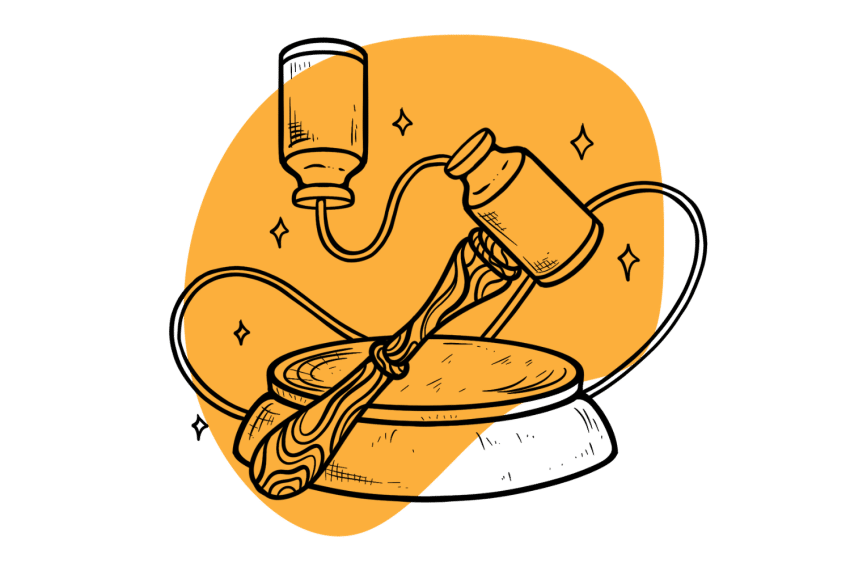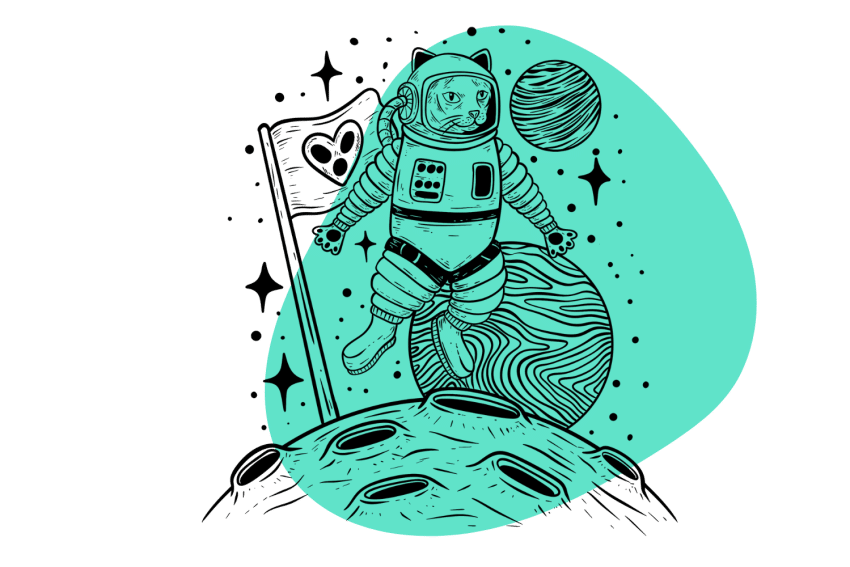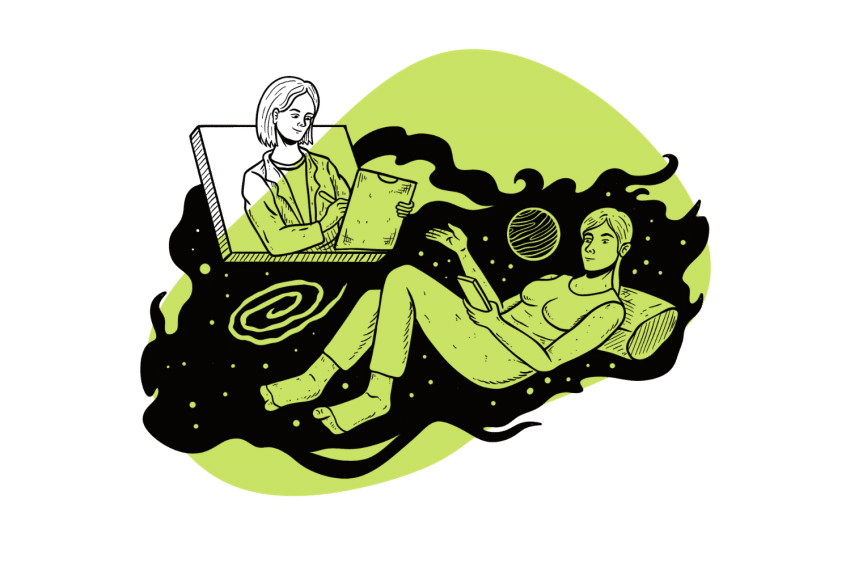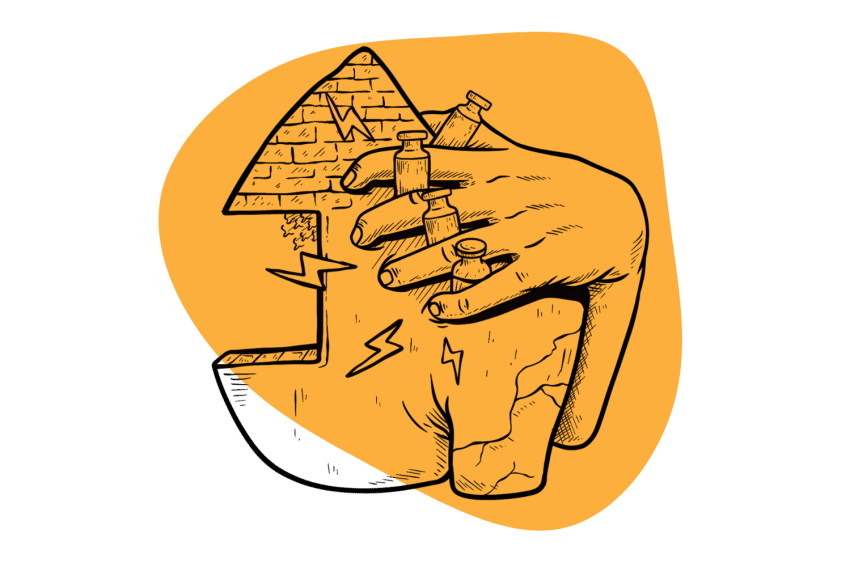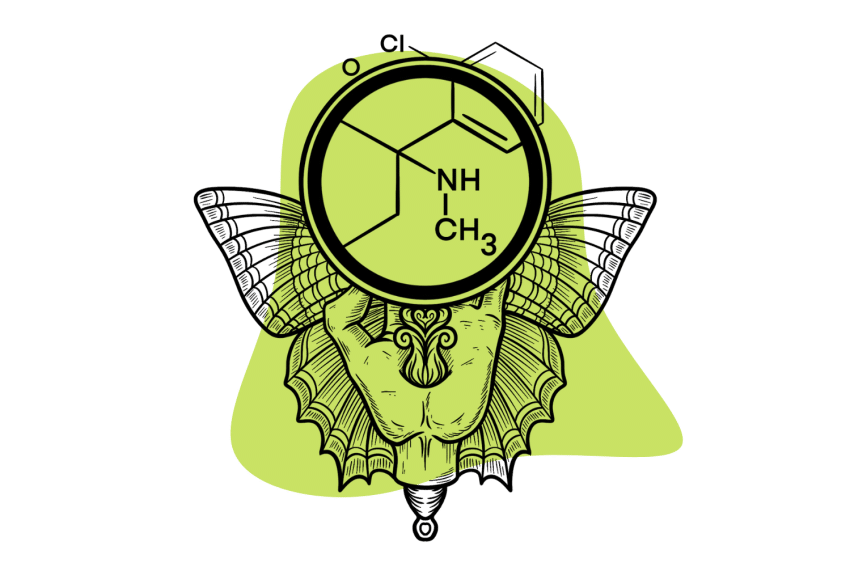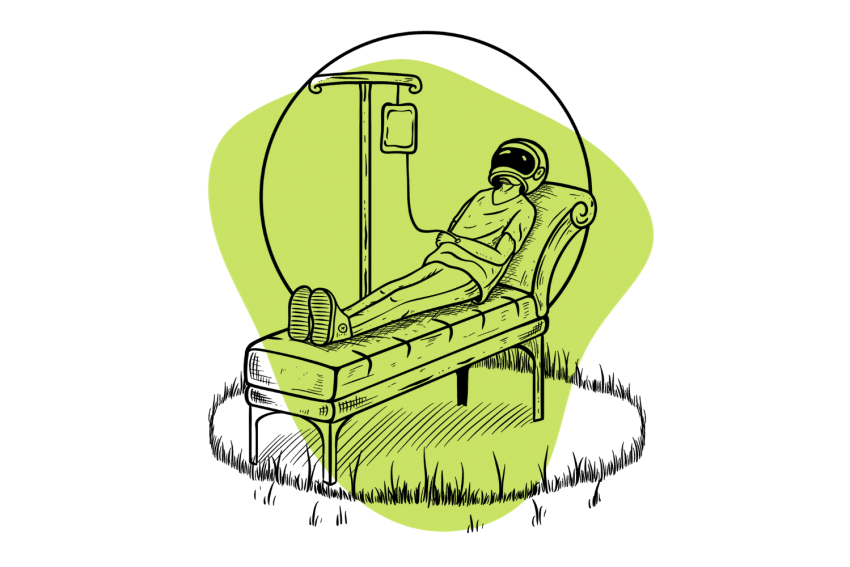What Are the Effects of Ketamine?
Ketamine’s effects share similarities with other psychedelics but with a few drastic differences — let’s cover what to expect from ketamine at different dosages.
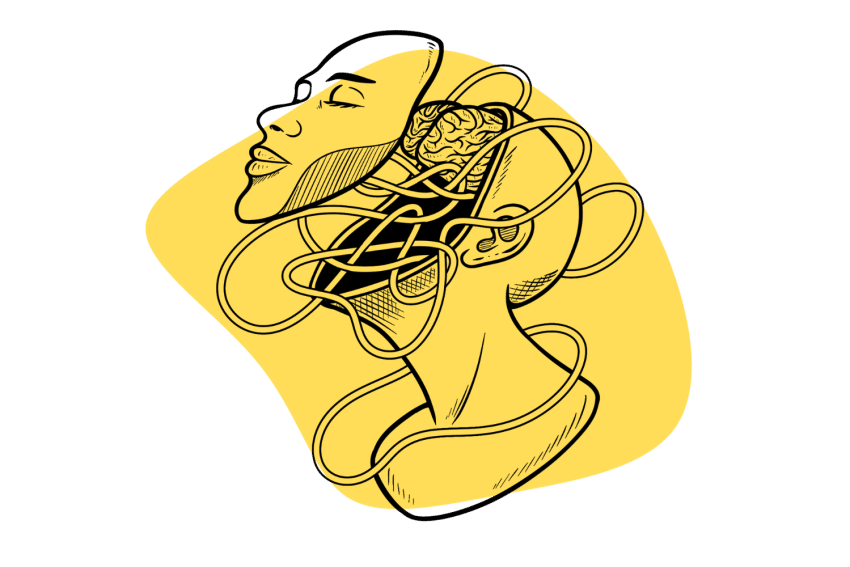
Whenever someone is considering using a new drug for the first time, knowing what to expect from the experience is essential — something that’s exceedingly difficult with psychedelic-like substances.
Introductory studies and ketamine telehealth clinics have led to a surge in ketamine interest — but much of this potential is over-sensationalized.
Despite some attempts to lump ketamine in with other “classic psychedelics” like LSD (lysergic acid diethylamide) or magic mushrooms, ketamine has some distinguishing considerations.
In this guide, we’ll tell you everything you need to know about the experience of ketamine, including:
- How dose and administration change ketamine’s effects
- Ketamine’s pharmacological, physiological, and psychological effects
- Side-effects and adverse reactions common to ketamine use
- How to test illicitly sourced ketamine
After, we’ll break down some of your frequently asked questions — feel free to jump straight to them if you’re here on a mission:
- Are Higher Doses of Ketamine Better?
- What Are the Dangers of Chronic Ketamine Use?
- Is Ketamine a Psychedelic?
- Can you Mix Ketamine With Other Drugs?
Let’s break down this complex drug and the ways it affects people who take it.
Ketamine Effects By Dose
Like many other drugs, the effects of ketamine vary depending on the dosage.
This breaks down into five basic groups:
- Threshold Doses — The lowest amount you can take and still feel some effect.
- Low Doses — Capable of introducing you to the effect of ketamine without being too overwhelming.
- Average Doses — A typical amount for most ketamine users when wanting to achieve the full effects.
- Strong Doses — Heavy amounts that make the experience more profound (and increase the potential for adverse reactions). With ketamine, this dose may make users lose coordination and begin dissociating from their body.
- “K-Hole” Doses — This is the term for a fully anesthetic dosage of ketamine, dissociating the user from their body entirely.
The below chart is a rough breakdown of the typical dosages to achieve each “level” of effects. NOTE: Every person is different, and dosages vary between individuals.
| Route of Administration | Dosage Levels |
| Oral | Threshold: 40–50 mg Low: 50–100 mg; Average: 100–300 mg Strong: 250–450 mg K-Hole: 450–650 mg |
| Intranasal (Sprays & Powders) | Threshold: 10–15 mg Low: 15–30 mg Average: 30–75 mg Strong: 60–125 mg K-Hole: 100–250 mg |
| Sublingual (Troches/Lozenges) | Most services offer 200–600 mg options — sublingual may be slightly more effective than oral routes, but dosages largely align. |
| Intravenous (IV) | Between 1–4.5 mg per kilogram of body weight, usually over 30–60 minutes |
| Intramuscular (IM) (Based on a weight of ~150 lbs) | Threshold: 15 mg (0.1 mg/lb) Low: 25 mg (0.15 mg/lb) Average: 30 mg (0.2 mg/lb) Strong: 75 mg (0.5 mg/lb) K-Hole: 110 mg (0.75 mg/lb) |
A) Threshold Dose
What Does a Threshold Dose of Ketamine Feel Like?
You may have to concentrate on how your body feels to experience any changes from ketamine in threshold doses. With low-to-medium doses of ketamine, the effects are often comparable to drunkenness with alcohol — this dosage is like drinking a beer.
You may notice a slight uptick in your attitude or a loosening of anxiety in a similar way, but the effect is unlikely to be pronounced.
B) Low Dose
What Does a Low Dose of Ketamine Feel Like?
At this level, ketamine’s drunken feeling will become apparent, and you will likely begin to see some light visuals. Ketamine is a dissociative, so it may be harder to move, and you might lack the motivation to do so around this level.
Coordination will likely not be to the point of restricting movement too much, but it will probably become noticeably harder. Euphoria is also common around this dosage, and you may notice the world around you getting brighter (figuratively or literally).
Coupled together, you’ll likely laugh about the new sensations you’re experiencing.
C) Standard Dose
What Does a Standard Psychoactive Dose of Ketamine Feel Like?
Around these levels, many find they crave isolation to lose themselves in the stream of thoughts and experiences. An average amount of ketamine will leave you feeling light and starting to detach from your bodily sensations — this often feels like floating or deep relaxation.
Hallucinations and out-of-body experiences also frequently start around this dosage. Time will begin to feel as though it has slowed down, as if you are crawling along, waiting for it to all end.
If you are planning to take an average dose or higher of ketamine, it’s crucial to have a trip sitter nearby. Detaching from the feelings of your body and coherent thought is a fun experience, but it can turn dark and traumatic at any point.
Always have a sober adult you know and trust when trying new drugs (or higher doses of drugs you’re familiar with).
D) High Dose
What Does a High Dose of Ketamine Feel Like?
First, you’ll begin to notice your thoughts flowing more rapidly. You may find it difficult or even impossible to move.
As the dissociation comes on, you’ll experience being “outside your body.” Some people describe this stage as “watching themselves from somewhere else.” You may or may not be able to maintain control over your body at this stage.
Hallucinations are very common as well at high doses. Ketamine is described by many to be one of the most truly “trippy” psychedelics they’ve ever used.
List of effects common at high dosages include:
- Dissociation
- Depersonalization
- Hallucinations
- Euphoria or Dysphoria
- Sedation
- Altered perception
- Impaired Motor Function
E) K-Hole Dose
What Does a K-Hole Feel Like?
“K-Hole” is a term enthusiasts use to describe the effects of exceptionally high doses of ketamine. At these levels, it can induce a full anesthetic and dissociative effect, severing users completely from their bodies, movements, and even sense of self.
Many describe the experience as feeling like they’re trapped in a black hole falling into forever — whether this is exciting or terrifying to you depends on your comfort and experience level.
To the experienced ketamine user, this effect is often what they are searching for, but it can be terrifying to anyone not expecting it (or, even if they are). Time, sensations of self, and normal thinking patterns vanish, leaving you with a dissolved personality you may not fully understand.
If you read that and it felt exciting instead of excruciating, the K-hole may be for you! That said, it isn’t for everyone, and plenty of people enjoy ketamine without ever feeling the need to visit that experience.
Similar to a “breakthrough” experience with dimethyltryptamine (DMT), over-emphasis on heavy and overwhelming doses often makes light of how terrifying a K-hole can be.
What to Expect When Taking Ketamine
Ketamine is similar to many other drugs in its complex nature of interrelated actions contributing to a total effect. The entire experience results from how ketamine interacts with the brain, body, and your sense of self — and each is important in its own way.
“Ketamine,” as we usually refer to it, is a racemic (equal parts) mixture of two complimentary molecules — S- and R-ketamine. While racemic ketamine dominates the off-label and telehealth market, Johnson & Johnson’s FDA-certified ketamine nasal spray (Spravato) contains just S-ketamine.
This will be important for some of the points below — slight differences exist between the two (and implications from combining/not combining them).
Ketamine’s Pharmacology
Ketamine interacts with various parts of the body, contributing to the total effect of the drug. Here’s a quick breakdown of some of ketamine’s effects on our pharmacology and how it expresses itself in the experience [1].
Here are some of the ways ketamine interacts with your brain and body:
| System | Ketamine’s Effects | Expression |
| Gamma-aminobutyric Acid (GABA) Neurotransmitters | Evidence for agonistic and antagonistic qualities along with slight elevation in concentrations in the brain | GABA is the primary chemical that inhibits the brain and is a prominent mechanism of action for alcohol, so this may contribute to the “drunken” feeling |
| N-methyl-d-aspartate Receptors (NMDAR) | Antagonist, binding to the same receptor as phencyclidine (PCP). S-ketamine has 4x the affinity as R-ketamine and 2x that of racemic | Blockading the NMDAR receptor is likely what leads to the anesthetic and dissociative effects of ketamine. This may also be what leads to cognitive disruptions of ketamine — many consider it the primary site of action for many of ketamine’s effects |
| Dopamine Receptors | Partial agonist of D2 Dopamine receptors, partial inhibition of dopamine transporters, and the ability for receptors to absorb them (uptake) | This may lead to larger amounts of dopamine in your system by blocking the capability to absorb the neurotransmitter, leading to euphoria and some of the psychotic-like feelings on ketamine |
| Serotonin Receptors | Antagonistic effects on a variety of receptor sites and an inhibitor of receptor uptake | Potentially plays into the euphoric elements of ketamine as well as some of the pain-relieving capabilities |
| Opioid Receptors | Agonist on all three opioid receptors — mu, kappa, and delta | Mu-opioid receptors are the leading site for pain relief; kappa and delta receptors help with pain while also potentially being responsible for many of the dissociative qualities of ketamine |
| Alpha-amino-3-hydroxy-5-methyl-4-isoxazolepropionic acid (AMPA) receptor | Antagonist — with some studies suggesting R-ketamine has a stronger affinity for binding [2] | This might be a major mechanism for long-lasting antidepressant relief [3] — Some research shows AMPA activity may increase dopamine and serotonin quantities in the brain (among other things) [4] |
While these are some of the direct actions of ketamine, it’s worth noting many of them set off other reactions within the body as well. AMPA, for example, interacts with dopamine and serotonin levels in intricate ways.
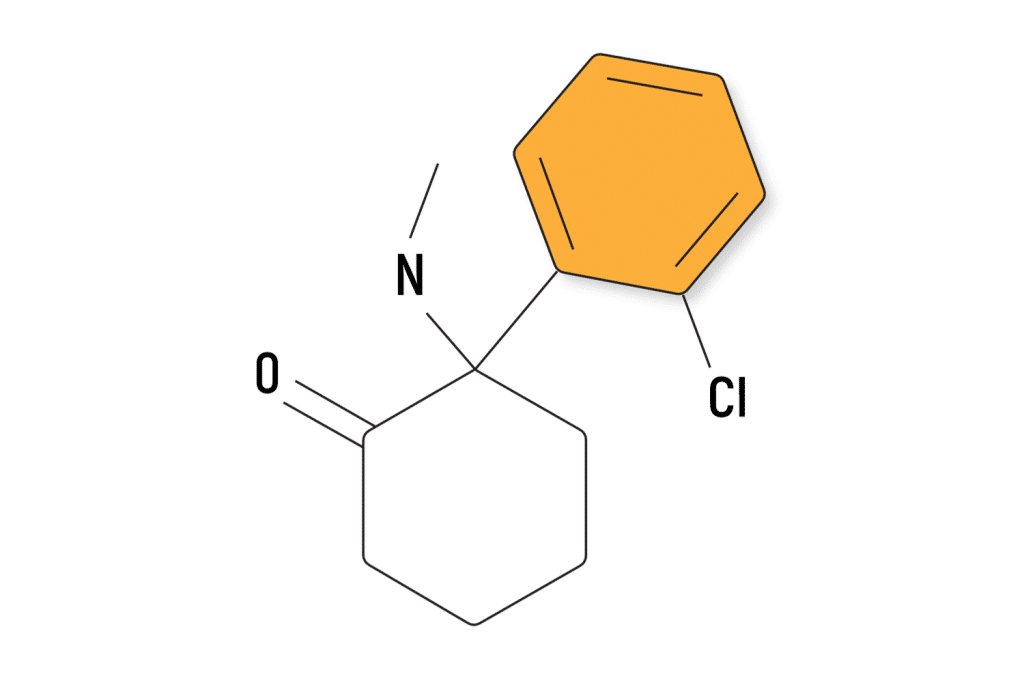
Ketamine’s Physiological Effects
After taking ketamine, users frequently report heavy feelings of sedation along with several other effects on their bodies.
Some common physical side effects include:
- Confusion and disorientation
- Loss of motor control
- Dizziness — sometimes to the point of nausea and vomiting
- Detachment from your sense of self and environment
Since ketamine is a short-acting drug, these effects are typically short-lived, and most find them mild — but everyone is different.
You can reduce some of the bodily effects of ketamine by maintaining a healthy diet of mostly fresh fruits and vegetables for a few days before your session.
How Ketamine Affects Your Sense of Self
Ketamine doesn’t feel like other psychedelics you may have tried since it has dissociative effects on top of psychological hallucinations and sensations. While some disconnection between mind and body is common in psychedelic experiences, ketamine stands alone in its pharmacological capabilities to do so.
GABA and NMDAR actions contribute significantly to this, but ketamine’s role as an opioid takes it to the next level. Importantly, ketamine’s action on opioid receptors doesn’t have the same cardiac and respiratory concerns as other opioids [5].
Still, this is your body’s most robust defense against pain, and agonism of opioid receptors cuts off the signals going back and forth, communicating pain to the brain. As a result, users can feel completely detached from their body — which is often how we define ourselves — and unable to feel or move it.
Some find this is a crucial element for treating depression, anxiety, or other mental health concerns, but this isn’t necessarily always the case. R-ketamine, for example, doesn’t seem to lead to much of an intoxicating effect (if it has one at all) but may be better for long-term depression treatment [4].
Its mechanism for doing so isn’t to send you on a trip; however, it’s to increase levels of dopamine and serotonin in the brain, largely the same goal of depression medications.
Ketamine Side-Effects
Any drug capable of altering your perception as greatly as ketamine can deserves respect, and you should approach it with caution. Any psychedelic experience can be terrifying and traumatic, but ketamine has other concerns around toxicity worth considering as well.
Here’s a quick breakdown of some of ketamine’s most prominent concerns for adverse reactions:
- Neurological Concerns With Ketamine — “[K]etamine may decrease the ability to self-monitor, increase emotional blunting, and increase activity in reward processing [6]” as a result of changes to the neurological makeup of frequent users.
- Psychiatric Concerns With Ketamine — Mindbloom’s recent (likely biased) survey even wound up with a patient dropping out due to worsening depression and another needing to receive in-person psychiatric care from worsening anxiety [7].
- Abdominal Concerns With Ketamine — People often feel abdominal pain after heavy ketamine use. If untreated, this can turn into a serious (and urgent) health problem.
- Urinary Concerns With Ketamine — Another patient in that Mindbloom survey (which excluded anyone with previous drug use, by the way) had to see a urologist following urinary cystitis (inflammation) after their fourth dose. Some studies have concluded as many as 30% of ketamine “abusers” could face urinary concerns [8].
- Ketamine Abuse and Addiction Potential — Anything capable of making you feel good carries a risk for compulsive behavior and problematic use. Ketamine’s capability to easily fit into anyone’s day makes this even more likely (not to mention potential pharmacokinetic reasonings).
When using ketamine, it’s important to practice extreme caution around your frequency and dosages. While adverse reactions seem possible for nearly anyone using ketamine, dosage and frequency are certainly tied to its likelihood.
Why You Should Always Test Your Ketamine
Another concern regarding ketamine is the high levels of drug contamination in illegal settings.
Drugsdata.org tests and publishes the results of illicitly sourced drugs and has found (among other things) in samples sold as ketamine:
- MDMA (3,4-Methylenedioxymethamphetamine)
- Caffeine
- Phenibut
- Methamphetamine
- DXM
- 4-CEC (a synthetic amphetamine)
For this reason, it’s imperative to make sure you’re testing your drugs every time (even if you’re getting a new batch from the same source).
Testing kits like this one on Dancesafe.org contain two reagents to test on a single sample using the “Morris” testing method:
- Measure out a small amount of your ketamine (5–10mg)
- Place one drop from each bottle on top of the powder
- Stir the mixture for 30 seconds
If you’re testing pure ketamine, it’ll show up as a light purple, analogs like DCK or 2-FDCK will appear blue, and other contaminations will appear green.
FAQs: The Ketamine Experience
Here are some common questions people ask regarding the experience of using ketamine:
1. Are Higher Doses of Ketamine Better for Therapeutic Use?
A report in 2019 surveyed other ketamine literature to ask this question and found it’s often not a consideration of researchers [9]. It did find that 37.5% of studies correlated the dissociative, subjective effects of ketamine (rather than simple use) with successful outcomes.
However, this leaves out several questions researchers have not yet begun to ask, and the simple truth is we don’t know which method of ketamine use is the best. R-ketamine is less “psychedelic” — in fact, it may not have an intoxicating effect at all — but some research suggests it may be better for long-term depression treatment, for example.
2. Is Frequent/Chronic Ketamine Use Safe?
No — ketamine’s toxic metabolites could lead to abdominal and urinary concerns, behavioral changes, and cognitive problems. Ketamine’s addictive potential compounds this concern.
As a rapid-acting drug, people can fit it easily into their daily lives; it’s especially easy for ketamine to become a drug of abuse and is exceptionally dangerous as one.
3. Is Ketamine a Psychedelic?
Technically speaking, ketamine is a dissociative anesthetic with psychedelic-like effects. Since the term “psychedelic” doesn’t refer to a strict category of drugs — are they purely serotonergic? What about MDMA, which is an amphetamine? Etc. — ketamine certainly can fit into this category.
However, it is important to distinguish between the effects of a pure hallucinogen like magic mushrooms and the dissociative opioid-like effects of ketamine. The experience will feel dramatically different, but many elements are similar.
4. Can You Mix Ketamine With Other Drugs?
Mixing ketamine with other drugs can be extremely dangerous and lead to an exacerbation of side effects and adverse reactions. This is especially true when mixing ketamine with benzodiazepines, opioids, and other relaxant-type medications.
While ketamine doesn’t have respiratory depressant or cardiotoxic effects like other opioids, it can exacerbate them if combined. A recent review of overdose deaths from ketamine between 2019 and 2021 found that ⅓ of people co-used ketamine with other drugs.
Some of these include benzodiazepines, alcohol, and opioids [10].
Subscribe to Tripsitter: Newsletter & Podcast
Unlock Your Mind: Subscribe for Expert Insights on Psychedelics 🍄🌵
References
- Ketamine and Ketamine Metabolite Pharmacology: Insights into Therapeutic Mechanisms—PMC. (n.d.). Retrieved September 26, 2023
- R-ketamine: A rapid-onset and sustained antidepressant without psychotomimetic side effects—PMC. (n.d.). Retrieved September 28, 2023
- He, J.-G., Zhou, H.-Y., Wang, F., & Chen, J.-G. (2022). Dysfunction of Glutamatergic Synaptic Transmission in Depression: Focus on AMPA Receptor Trafficking. Biological Psychiatry Global Open Science, 3(2), 187–196.
- Ago, Y., Tanabe, W., Higuchi, M., Tsukada, S., Tanaka, T., Yamaguchi, T., Igarashi, H., Yokoyama, R., Seiriki, K., Kasai, A., Nakazawa, T., Nakagawa, S., Hashimoto, K., & Hashimoto, H. (2019). (R)-Ketamine Induces a Greater Increase in Prefrontal 5-HT Release Than (S)-Ketamine and Ketamine Metabolites via an AMPA Receptor-Independent Mechanism. International Journal of Neuropsychopharmacology, 22(10), 665–674.
- Orhurhu, V. J., Vashisht, R., Claus, L. E., & Cohen, S. P. (2023). Ketamine Toxicity. In StatPearls. StatPearls Publishing.
- Ionescu, D. F., Felicione, J. M., Gosai, A., Cusin, C., Shin, P., Shapero, B. G., & Deckersbach, T. (2018). Ketamine-Associated Brain Changes: A Review of the Neuroimaging Literature. Harvard Review of Psychiatry, 26(6), 320–339.
- Hull, T. D., Malgaroli, M., Gazzaley, A., Akiki, T. J., Madan, A., Vando, L., Arden, K., Swain, J., Klotz, M., & Paleos, C. (2022). At-home, sublingual ketamine telehealth is a safe and effective treatment for moderate to severe anxiety and depression: Findings from a large, prospective, open-label effectiveness trial. Journal of Affective Disorders, 314, 59–67.
- Chu, P. S.-K., Ma, W.-K., Wong, S. C.-W., Chu, R. W.-H., Cheng, C.-H., Wong, S., Tse, J. M., Lau, F.-L., Yiu, M.-K., & Man, C.-W. (2008). The destruction of the lower urinary tract by ketamine abuse: A new syndrome? BJU International, 102(11), 1616–1622.
- Mathai, D. S., Meyer, M. J., Storch, E. A., & Kosten, T. R. (2020). The relationship between subjective effects induced by a single dose of ketamine and treatment response in patients with major depressive disorder: A systematic review. Journal of Affective Disorders, 264, 123–129.
- Palamar, J. J., Fitzgerald, N. D., Grundy, D. J., Black, J. C., Jewell, J. S., & Cottler, L. B. (2023). Characteristics of poisonings involving ketamine in the United States, 2019–2021. Journal of Psychopharmacology, 37(8), 802–808.

